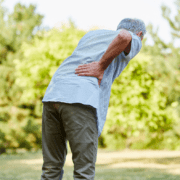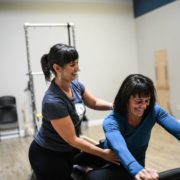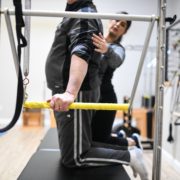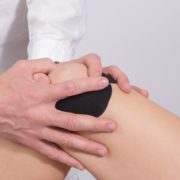Three Reasons Back Pain Sufferers Avoid Exercise (and what you can do)
80% of the population suffers from what we call “non-specific low back pain”. Low back pain is typically chronic, comes out of nowhere, you have good days and bad days, and it’s not usually due to any recent or major accident or fall. If you’ve got back pain and you’re reading this – odds are pretty good that you suffer from non-specific low back pain. Research shows that exercise is the best treatment for non-specific low back pain.
But what do you do when your back pain keeps you from the thing that’s supposed to help you?
Here are three of the most common reasons I see that keep people with low back pain from exercising – and some tips for what you can do:
1. Fear
Let’s face it – back pain is scary.
This is the number one reason back pain sufferers don’t exercise. Is the pain you’re feeling good or bad? Should you be feeling any pain at all? Pain is confusing. When you experience pain during exercise, it can be difficult to know if it’s normal or a warning sign. For many, the safest thing to do (as they see it) is avoid any exercise or movement altogether until the pain subsides.
The problem is – when you try to resume movement again – the pain comes right back – and then you’re caught in a vicious cycle.
What you need to figure out is which movements are “good” and which movements are “bad” – and the good news is your body is going to tell you. If you hurt a little at first – but feel better the more you do something – and aren’t worse after – you can consider that movement generally safe and be encouraged to keep trying it.
But if you hurt during – and feel worse after – then that’s a sign to stop and back off. Pain is not something to fear – it’s just information. What’s important is how your back pain behaves over a period of time with a certain activity.
Fear of pain comes from not knowing what it is or what to do – but when you figure out how to “speak pain” – the fear goes away and you can have control over your body again.
2. Bulging Discs
Most people who suffer from long-standing low back pain eventually find themselves getting an MRI. And 60-70% of the time, it will show one or more bulging discs.
If you’ve been following me for a while, you know that most people over the age of 40 walk around with bulging discs – and that 65% of them feel no pain at all. In other words, if you’ve got a bulging disc, you can’t be certain it’s the cause of your back pain. Research proves this. And being told you’ve got a bulging disc is not a reason alone to avoid exercise.
Movement is actually one of the best things you can do for a bulging disc.
It may require some customization of your current exercise routine, but a movement specialist can help you with this. Don’t just stop or avoid exercise altogether just because you’ve been told you have a bulging disc. Go back to the rules of pain I mentioned above and let that be your guide instead.
3. You Were Told to Rest
Well-meaning doctors and family members who aren’t up to date on the latest back pain research will advise you to rest every time you experience back pain.
This might be reasonable advice when you’re dealing with an acute (sudden) episode of back pain – but it’s terrible advice for chronic, non-specific low back pain sufferers.
Rest is one of the worst things someone with chronic back pain can do. Since most people don’t have a thorough understanding of this concept, they find themselves in a yo-yo effect.
They rest to “heal” their back pain. When it’s gone they return to exercise – only to hurt their back again. I’ve seen so many people fall victim to this perpetuating cycle and it’s a big reason why so many back pain sufferers just give up on exercise entirely.
If it’s been a long time since you’ve exercised – start with 10 min of daily walking.
Walking is generally known to be one of the best things you can do for back pain. If for some reason walking increases your back pain – then that’s a good reason to see a back pain specialist (ideally one who understands how to heal your back with movement versus pills and procedures).
If you’re suffering from chronic, non-specific low back pain – and you’ve stopped exercising – know that you’re not alone.
This is such a confusing topic and there are so many mixed messages out there about what the “right” and “wrong” thing to do is. Don’t try to go at it alone. Exercise is good for your back, but you may just need a little help and guidance to get there.
Need help with Back Pain now? Are you Local to Portsmouth, NH? CLICK HERE to speak with one of my specialists. We will see what’s been going on with you – and get you on a treatment plan right away.
We will be talking all about Back Pain in our upcoming Masterclass! Its free – via zoom – on September 19th. Reserve your seat here! Learn how to manage your back pain on your own – and get back to doing the activities that you love – pain free!
Dr. Carrie Jose, Physical Therapist and Pilates expert, owns CJ Physical Therapy & Pilates in Portsmouth and writes for Seacoast Media Group. To request a free copy of her guide to back pain CLICK HERE or to get in touch, email her at [email protected].











